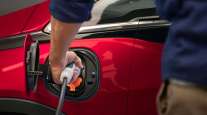Contributing Writer
Medium-Duty Segment Offers Entrée to Fleet Electrification

[Stay on top of transportation news: Get TTNews in your inbox.]
With its potential use and broader recharging capabilities, the medium-duty truck market will adopt battery-electric vehicles faster than the heavy-duty one will, experts and industry officials say.
Adoption, in fact, could happen quickly. Ann Rundle, ACT Research’s vice president of electrification and autonomy, believes electric trucks will comprise 38% of the Classes 4-5 market and 30% of the Classes 6-7 market by 2030.
Wilfried Aulbur, senior partner with Roland Berger, a global consulting firm, said the medium-duty electric vehicle market could reach 30% to 40% or even higher by 2030.
“The environment is very positive,” Aulbur said. “The move toward electrification and toward sustainable solutions is, in my opinion, something that cannot be turned around.”
A number of factors contribute to the medium-duty advantage over heavy-duties when it comes to battery-electric trucks. Medium-duties travel shorter distances so they can finish their routes on one charge, and they regularly return to their base where they can recharge overnight. Stop-and-go driving creates regenerative braking opportunities that recharge batteries on the road. Medium-duties are more likely to run out of space or “cube out” than they are to reach their gross vehicle weight limit, so they’re not penalized by the batteries’ weight. Heavy-duties more often reach their weight limit.
Jake Montero, general sales manager for vocational and medium duty for Peterbilt, noted that the medium-duty EVs are becoming a more viable option for customers.
“Everything that goes into supporting a heavy-duty EV is more expensive than with a medium-duty EV. Heavy-duty EVs need larger batteries for similar ranges because they are hauling more weight,” he said. “Larger batteries drive vehicle purchase costs higher and necessitate higher power chargers to charge them in a similar time. Higher power chargers cost more to purchase and can require more infrastructure investment.”
Debbie Shust, Navistar vice president of medium-duty business, said medium-duty fleets can dip their toe in the water and easily install a 240-volt AC charger, while heavy-duty haulers will need utility company involvement with the infrastructure build-out.

Navistar has a committed goal of having 50% of its sales from electric vehicles by 2030. (Navistar)
She said the OEMs’ medium-duty electric trucks are two to three times more expensive than diesels, but with lower maintenance, fuel savings and government incentives, they can reach total cost of ownership parity. Electric trucks require 40% to 50% less maintenance because they have far fewer moving parts.
Navistar’s Classes 6-7 eMV has been in production since August 2021, but it wasn’t the company’s first electric transportation venture. The company first introduced electric school buses, from which it learned lessons it has applied to trucks and vice versa. It plans to have an electric Class 8 truck in the fourth quarter of 2024.

Shust
“We’ve made a commitment that by 2030, 50% of our sales are electric, so we’re all in,” Shust said.
She said regulations will drive the move toward medium-duty electrics. California’s Advanced Clean Trucks rule requires manufacturers to sell an increasing percentage of zero-emission trucks in that state starting in 2024, with higher percentages required among vocational trucks than tractors. In 2024, 9% of Classes 4-8 vocational trucks sold must be zero-emission trucks versus 5% of Classes 7-8 tractors. By 2035, the numbers are 75% and 40%.
The Advanced Clean Fleets rule has motivated customers to think about what steps they must take to comply, said Stephan Olsen, Kenworth general sales manager. He said regulations are the primary driver of customer demand, and he expects volumes to increase as they go into effect.
Kenworth is in the second year of producing its K270E Class 6 and K370E Class 7 trucks. Olsen said the company’s sales have reached hundreds of trucks a year. Buyers include port and drayage fleets, municipalities, utilities, refuse companies and large global corporations with recognizable brands and public images.

Analysts believe that the medium-duty electric vehicle market could reach 30% to 40% or even higher by 2030. (Kenworth)
He noted there are business benefits to switching to electric trucks, including less maintenance. Touch points like oil changes and DPF cleanings go away, while regenerative braking reduces wear and tear on brakes.

Olsen
“We say these trucks are coming, but the reality is these trucks are here,” he said. “The regulatory requirement is here, and the movement is now. There are customers who recognize that adoption of electric trucks is not a sprint, it’s a marathon.”
Two factors will speed adoption of the technology in all sizes, ACT Research’s Rundle said. Battery technology is improving and becoming more efficient, allowing smaller battery packs and more weight for hauling, reducing the total cost of ownership.
Regulatory Action
Meanwhile, government policies are reducing the price differences between electrics and diesels. California is offering $85,000 in incentives for a qualifying medium-duty electric truck, while the Inflation Reduction Act offers $40,000. At the same time, federal nitrogen oxide rules coming in 2027 will add to a diesel truck’s cost, Rundle said.
Navistar had assumed that box trucks would be the natural initial medium-duty market.
“But the reality is we have had customers in the vocational space almost from day one raising their hand, interested in this product. … We started with a box truck, and when all this interest came on the vocational space, we quickly pivoted because that’s what customers were asking for,” Shust said.
Utilities have a natural business interest in electric vehicles — electricity is what many of them do, after all — and are purchasing bucket trucks. Navistar this year will offer a factory-installed electronic power takeoff, which is a motor for hydraulic equipment. Shust said electric trucks’ quieter operation allows drivers to talk to their coworker in the bucket.

Medium-duty EVs offer advantages such as shorter travel distances and regenerative braking opportunities. (Navistar)
Brian Daniels, vice president of vocational national accounts at Daimler Truck North America, said interest in electric trucks is at an all-time high. The company premiered its eM2 battery electric box truck for pickups and deliveries at the Advanced Clean Transportation (ACT) Expo this spring and said it is ready to order, with production to start this fall. But he said infrastructure challenges are hindering growth among customers in the electric vehicle market.
“Many of them are concerned about changes in the regulatory landscape in the future and wonder if they will have to overhaul their company’s processes again,” he said.
Canadian-based Lion Electric introduced its Lion 5 Classes 5-6 vehicle at ACT Expo to go along with its Lion 6 medium-duty and Lion 8 heavy-duty offerings. The company is active in both the Canadian and U.S. markets.
Patrick Gervais, vice president of trucks and public affairs at Lion, said the environment north of the border is supportive. Canada’s federal government will provide $100,000 to $150,000 toward the cost of a vehicle, while provinces have incentives that can be added to that. In Quebec, fleets can receive $125,000 for a Class 6 vehicle and $175,000 for a tractor, and if the trucks are manufactured in Canada, they receive a 15% bonus.
“I don’t see right now with the savings on fuel and on maintenance, there’s no reason if you’re doing 200, 255 miles or less per day to not go electric in Canada right now,” he said.
New EVs, New Challenges
Buying the truck is only part of introducing electric vehicles to a fleet. Daimler Truck North America’s Daniels said customers should be prepared for the other issues they will face. DTNA’s Detroit eConsulting team supports customers with charging, site selection, connectivity and energy storage. The company’s joint venture, Greenlane, is supporting a national electric charging and hydrogen-fueling network.

Hayden Cardiff, co-founder and chief innovation officer of Idelic, discusses predictive analytics software and scoring driver practices. Tune in above or by going to RoadSigns.ttnews.com.
Navistar’s zero-emission team will consult with fleets to help them determine how best to migrate to the new technology. Shust said some fleets have struggled with battery weight and have had to buy two trucks to do the work of one, or move up in class. The latter can be problematic because if a fleet is going from a Class 6 to a Class 7, it has crossed a CDL line, and if it goes from Class 7 to Class 8, it has crossed a federal excise tax line. She said Navistar works with fleets on weight reduction plans.
Kenworth’s Olsen said his team includes a dedicated grant writer who is familiar with current and upcoming grants and can help fleets manage and navigate the application process. The key is getting the right battery-electric vehicle (BEV) for a customer’s needs.
“It’s not to say that BEVs are a slam dunk and we’ve got it solved as an industry,” Olsen said. “I think the technology’s understood. It’s really about how we integrate the trucks into our various customers’ operations.”
Olsen doesn’t foresee a technology step-up in the near future. The technologies are being deployed. The industry needs scale and for the infrastructure to be built. He is cautiously optimistic that it will be.
“I’m more confident than I was yesterday. … Every day we get closer,” he said.
Want more news? Listen to today's daily briefing below or go here for more info:




